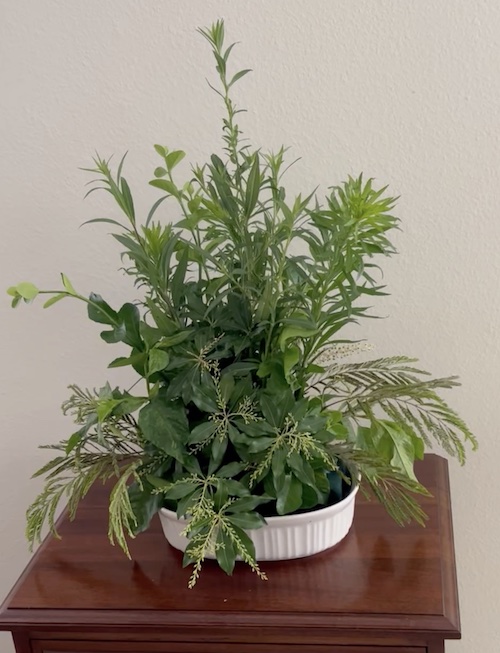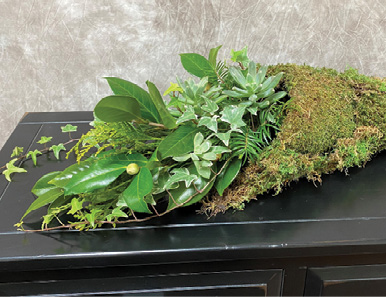No Flowers, No Problem! All Foliage Floral Arrangements
by Elizabeth Cornell Fake, Fairfax Master Gardener
 When there are no blooming flowers in the garden or you forgot to pick up a grower’s bunch at the grocery store, it is time to try an all foliage floral design. It is one of the most versatile designs and one of the easiest to execute with what you have growing in your backyard or find in a nearby field. Most floral designers consider all foliage arrangements to be among their best tricks of the trade. Best of all, they far outlast the life of a traditional flower array by as much as a week. Foliage arrangements can be made a day or two ahead of an event, with no spoilage caused by wilted flowers. There are several considerations that ensure success of an all green design: selection and conditioning of materials, arrangement and mechanics of construction and maintenance.
When there are no blooming flowers in the garden or you forgot to pick up a grower’s bunch at the grocery store, it is time to try an all foliage floral design. It is one of the most versatile designs and one of the easiest to execute with what you have growing in your backyard or find in a nearby field. Most floral designers consider all foliage arrangements to be among their best tricks of the trade. Best of all, they far outlast the life of a traditional flower array by as much as a week. Foliage arrangements can be made a day or two ahead of an event, with no spoilage caused by wilted flowers. There are several considerations that ensure success of an all green design: selection and conditioning of materials, arrangement and mechanics of construction and maintenance.
Selection and Conditioning of Materials
Most floral designs are built around three types of materials: focal flowers, fill flowers and foliage greenery. Focal flowers provide the eye catching interest part of the design. Fill flowers support the focal flowers with contrasting color and texture. The greenery sets the vertical and horizonal axis and shape of the arrangement. For a design made from foliage only, the greenery has to do the work of all three kinds of materials. The best strategy is to use eight to ten different kinds of foliage that contrast in form, color, texture, size and height. Decide what will serve as the focal and fill elements and then supplement with other greenery selections to unify the focal and fill pieces through vertical and horizontal lines. Here are some suggestions for each type of foliage material.
Focal
Set the tone and focus of the design with foliage that makes a statement such as Caladium (Caladium bicolor) Canna (Canna indica), Artemisia (Artemisia vulgaris), Coleus (Plectranthus scutellarioides), Coral Bells (Heuchera), Hosta (Hosta plantaginea), Saucer Magnolia (Magnolia x soulangeana), Persian Shield (Strobilanthes dyerianus), Elephant Ears (Colocasia esculenta), Lambs Ear (Stachyz byzantina), Scented Geranium (Pelargonium), Lungwort (Pulmonaria officinalis) and Sedum (Sedum mexicanum).
Fill
 Support the focal selections with texture and contrasting color using herbs including Mint (Mentha spicata), Lavender (Lavandula angustifolia), Oregano (Plectranthus amboinicus), dark purple basil (Ocimum basilicum), Sage (Salvia greggii) and nasturtium (Tropaeolum majus). Grasses such as Blood Grass (Imperata cylindrica), Porcupine Grass (Miscanthus sinensis), and Zebra Grass (Miscanthus zebrinus), though not technically foliage, can add fullness and color. Japanese Painted Fern (Anthyrium niponicum) adds texture and fills space without overwhelming the focal items. Other materials to add texture include Sweet Potato Vine (Ipomoea batatas), Dusty Miller (Centaurea cineraria), Nandina (Nandina domestica), Plumosa (Asparagus plumosus) and Boxwood (Buxus sempervirens). Easy to forage Raspberry greens (Rubus idaeus var. strigosus) are a staple filler. Your backyard Privet (Ligustrum sinense) hedge is a workhorse filler foliage.
Support the focal selections with texture and contrasting color using herbs including Mint (Mentha spicata), Lavender (Lavandula angustifolia), Oregano (Plectranthus amboinicus), dark purple basil (Ocimum basilicum), Sage (Salvia greggii) and nasturtium (Tropaeolum majus). Grasses such as Blood Grass (Imperata cylindrica), Porcupine Grass (Miscanthus sinensis), and Zebra Grass (Miscanthus zebrinus), though not technically foliage, can add fullness and color. Japanese Painted Fern (Anthyrium niponicum) adds texture and fills space without overwhelming the focal items. Other materials to add texture include Sweet Potato Vine (Ipomoea batatas), Dusty Miller (Centaurea cineraria), Nandina (Nandina domestica), Plumosa (Asparagus plumosus) and Boxwood (Buxus sempervirens). Easy to forage Raspberry greens (Rubus idaeus var. strigosus) are a staple filler. Your backyard Privet (Ligustrum sinense) hedge is a workhorse filler foliage.
Greenery
Establish the height and width of the design with shrub and tree cuttings from Crape Myrtle (Lagerstroemia indica), Ninebark (Physocarpus opulifolius), European Hornbeam (Carpinus betulus) and Beech (Fagus grandifolia). Other foliage such as Myrtle (Myrica californica), Eucalyptus (Eucalyptus cinerea), Phormium (Phormium tenax), Holly (Ilex opaca), Pittosporum (Pittosporum tobira), Dracaena (Dracaena surculose), Camellia (Camellia japonica) and Euonymus (Euonymus japonicus), establish the design lines that build the rest of the arrangement.
Collect materials mid-morning using a sharp pair of pruners making clean diagonal cuts across the bottom of the stem. For woody stems, cut up to one inch across the bottom to open the stem for more water uptake. Hydrate immediately in a conditioning solution and keep the foliage out of the sun until time for arrangement.
Arrangement and Mechanics
Choose a sturdy container with a flat bottom for the foliage design. Contrast the variety of the foliage elements with simple wood, metal, or ceramic receptacle. For the best results, use a biodegradable floral foam that has been soaked in water for at least thirty minutes. Attach the floral foam to the container with hot glue or green floral tape. Begin the arrangement with placement of the line and design foliage and then add the focal pieces. Complete with more filler elements, adding as many as space allows. Don’t forget to use floral finishing spray to ensure the longevity of the design.
Maintenance
The best part about foliage designs is that they need little or no maintenance and can last as long as two weeks with modest watering every few days.
Foliage floral design can be pursued to a highly sophisticated level as shown in many videos on the Internet. They are interesting to see, provide great ideas for your own designs and offer advanced floral design techniques that raise the quality of your work. But foliage designs are something anyone can do. Go out in your yard, or a vacant lot, find some materials and have fun!
References
• How to Make an All Foliage Arrangement Using Garden Foliage, National Association of Flower
Arrangement Societies, Royal Horticultural Society, Chelsea
• The Art of Floral Design, 3rd edition. Delmar Cengage Learning,
• Greenery Options for Floral Design, Sophie Felts, Team Flower Education